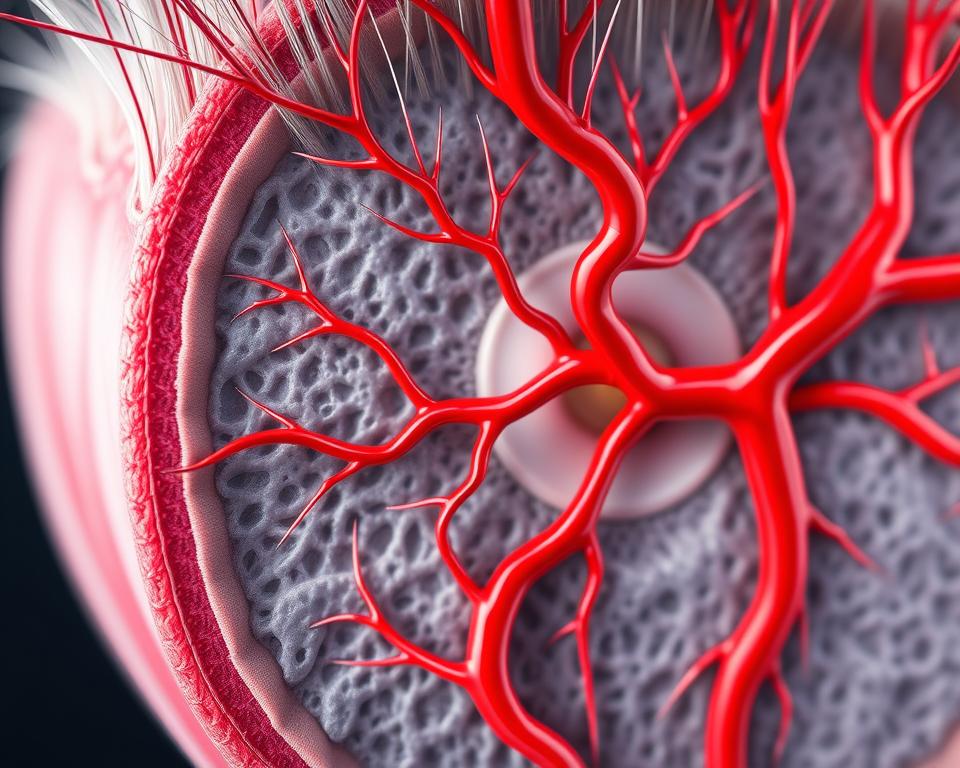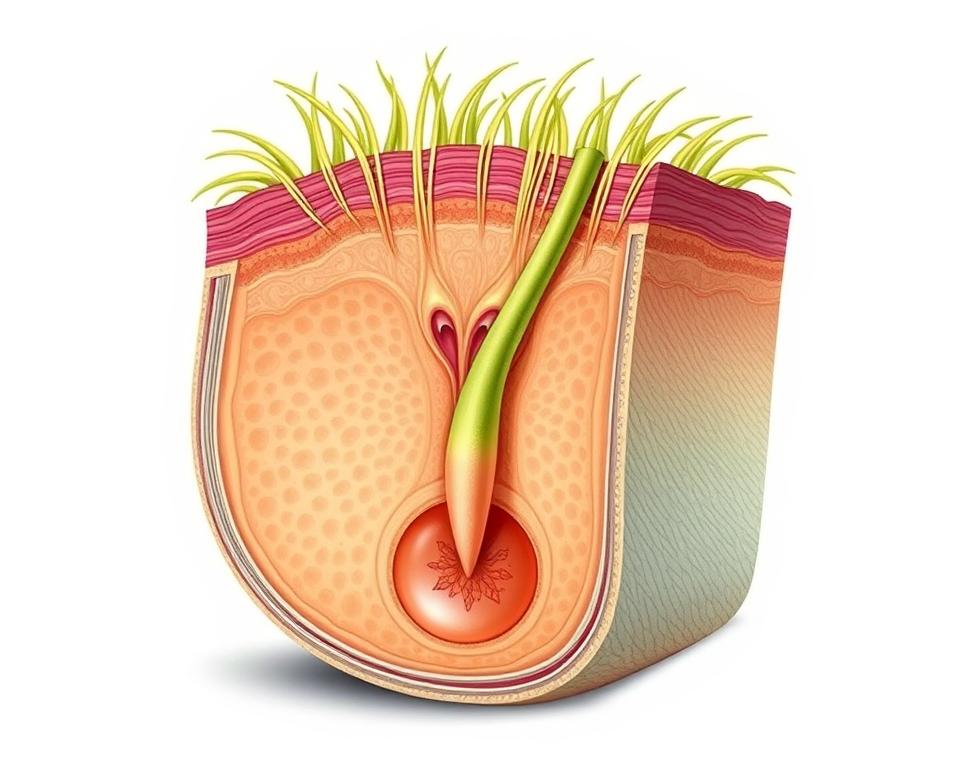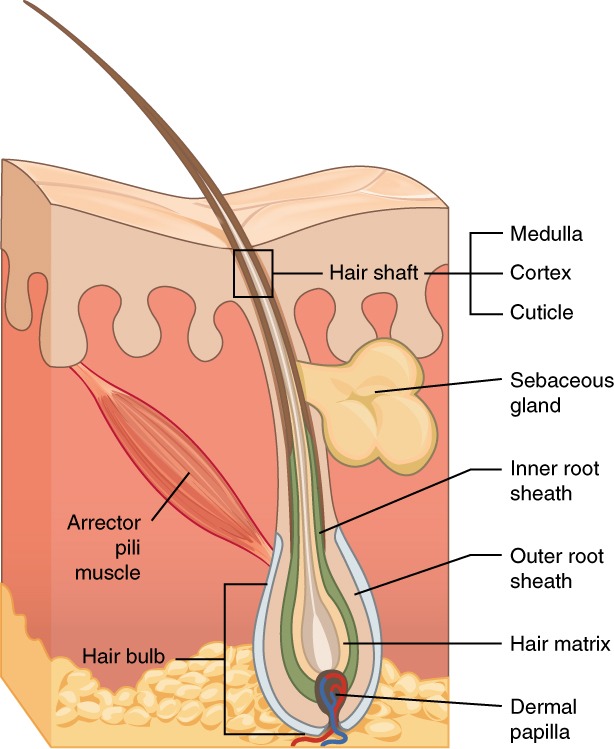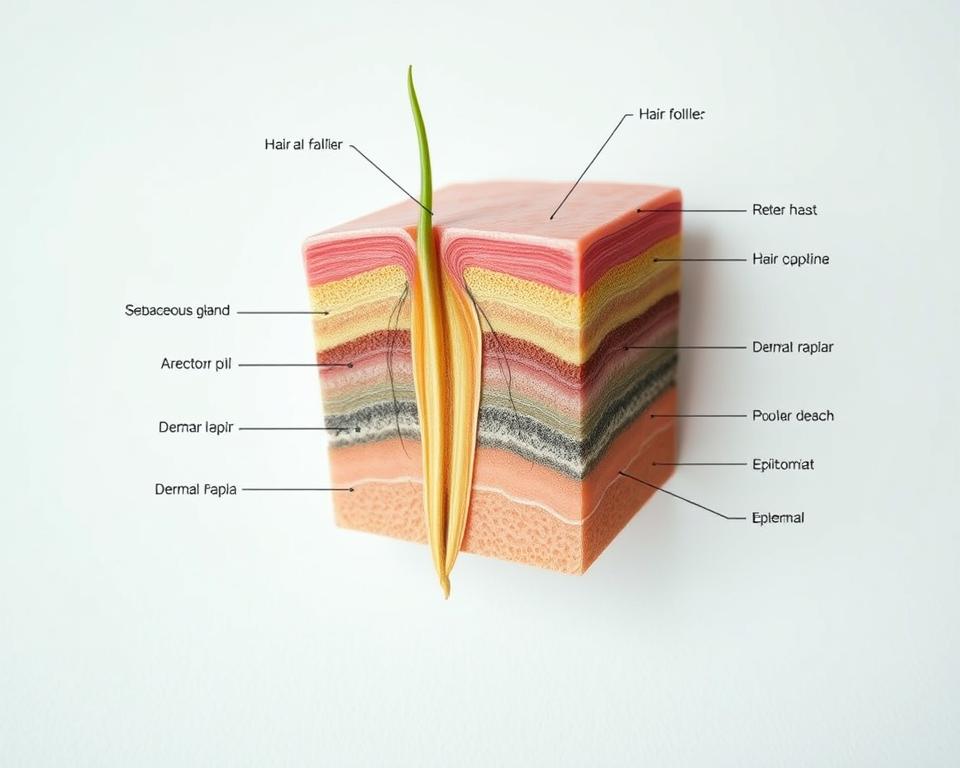Did you know that the average human has about 100,000 to 150,000 hair follicles on their scalp1? Knowing about hair follicles is key to understanding hair growth and health. A hair follicle is a small part inside the skin that helps hair grow. It also has glands that make and release sebum1. You can learn more about hair follicle health and function in the next sections.
Exploring hair follicles shows how vital blood and nerve supply are for healthy hair. Knowing about hair follicle definition and structure helps us grow healthy hair and avoid hair loss.
Key Takeaways
- Understanding the hair follicle definition and structure is key to knowing how they help with hair growth and health.
- The average human has about 100,000 to 150,000 hair follicles on their scalp1.
- A balanced diet with at least 50 grams of protein daily is best for hair growth2.
- Hair grows in three phases: Anagen (active), Catagen (transitional), and Telogen (resting)1.
- Chronic stress can cause hair loss by making follicles rest instead of grow2.
- People are born with about 80,000–120,000 hair follicles on their scalp2.
- It’s normal to lose about 100 hairs a day as we age2.
Understanding the Hair Follicle: Basic Definition and Overview
Exploring hair care means learning about the hair follicle and its role in hair growth. Humans have about 100,000 hair follicles on their scalp3. Hair grows about half an inch each month3.
The growth process has three phases: anagen, catagen, and telogen. The anagen phase, or growth phase, lasts 3 to 7 years3. The catagen phase is a short transitional phase, lasting 2 to 4 weeks4. The telogen phase, or resting phase, can last several months4.
Diet and stress affect hair follicle function. Eating well is key for healthy hair follicles. The hair follicle diagram shows the sebaceous gland, which keeps hair and scalp healthy. Knowing about the hair follicle helps keep hair healthy and prevents loss. About 90% of hair follicles are in the anagen phase at any time3.
Here are some key facts about hair follicles:
- The average person loses about 100 strands of hair a day3.
- About 90% of a person’s total hair is in the growth phase (anagen phase) at any time4.
- The growth phase for hair on the head can last several years, allowing it to grow over a meter in length if not cut4.
Understanding the hair follicle and its parts helps promote healthy hair growth and prevent loss. Eat well, reduce stress, and care for your hair follicles to keep your hair looking great.
The Complex Structure of Hair Follicles
The blood supply to hair follicles is key for nourishing hair cells. It delivers hormones that help hair grow and change5. This process is vital for keeping hair healthy.
Blood vessels around the follicle give hair the nutrients and oxygen it needs6. This shows how important good blood flow is for hair growth.
The hair follicle’s design helps with this process. The dermal papilla has capillaries that work with the hair matrix6. This teamwork is essential for getting nutrients and hormones to the hair.
Growth factors, like vascular endothelial growth factor, also play a role. They help control blood flow to hair follicles during the hair cycle6.
Knowing about hair follicle structure and blood supply is key for healthy hair. By focusing on good blood flow and nutrient delivery, people can help their hair grow and prevent loss5.

Essential Functions of Your Hair Follicles
Your hair follicles are key to keeping your hair healthy and your body well. They make hair, control oil, and help with temperature. The hair follicle nerve supply is also vital for their work. Studies show that most hair follicles are growing, while some are resting or shrinking7.
Humans have 2 to 5 million hair follicles, with 100,000 on our scalp8. Hair follicles have 20 different cell types, each with its own job7. Knowing about the hair cycle helps keep your hair healthy and stops it from falling out.
Stress, hormonal changes, injury, disease, and some medicines can cause hair loss8. Keeping your scalp and hair follicle nerve supply healthy is key. By understanding hair follicles and caring for them, you can grow healthy hair and feel better overall.
| Hair Growth Phase | Duration |
|---|---|
| Anagen (growth) phase | 2-8 years for scalp hair, 4-7 months for eyebrow hair7 |
| Catagen (regression) phase | 2-3 weeks7 |
| Telogen (resting) phase | around 3 months7 |
Visual Guide: Anatomy of the Hair Follicle
To grasp the hair follicle’s anatomy, it’s key to look at the hair follicle diagram. This diagram shows the follicle’s complex structure. It includes the hair shaft, root sheath, and dermal papilla9. The dermal papilla is vital for hair growth and decides on hair thickness, color, and texture10.
A hair follicle diagram also highlights the hair bulb, where new hair cells are made. It shows the root sheath, which guards the follicle’s inner parts9. The hair shaft has three layers: the cuticle, cortex, and medulla11. Knowing the hair follicle’s anatomy is vital for biology studies and in fields like dermatology, cosmetology, and trichology.
Here are some key points about the hair follicle’s anatomy:
- The hair follicle is a complex structure with many layers and parts9.
- The dermal papilla controls hair growth and decides on hair thickness, color, and texture10.
- The hair shaft has three layers: the cuticle, cortex, and medulla11.
By studying a hair follicle diagram, you can better understand the hair follicle’s anatomy and function. This knowledge helps in keeping hair healthy and solving hair problems9.
Blood Supply to Hair Follicles: Nourishment Pathways
The blood supply to hair follicles is key for their health. Blood vessels around the follicles bring the needed nutrients for growth12. This connection is vital for delivering oxygen and nutrients, helping hair grow and develop well.
Having enough blood supply is essential for hair follicle health. It ensures the delivery of vital nutrients and oxygen13. The hair growth cycle, with its anagen, catagen, and telogen phases, relies on this blood supply14. Knowing how blood supply affects hair follicles can help prevent hair loss.
Age, genetics, and health can affect the blood supply to hair follicles13. A healthy lifestyle, including a balanced diet and exercise, can boost blood flow. This supports hair growth.

To summarize, the key points for hair follicle blood supply and health are:
- Importance of blood supply for hair follicle health
- Connection between circulatory system and hair follicles
- Influence of blood supply on hair growth cycle
- Factors that impact hair follicle blood supply and health
Understanding the role of blood supply in hair follicle health is important. It helps individuals take steps to promote healthy hair growth and prevent loss12.
Understanding Hair Follicle Nerve Supply
The nerve supply to hair follicles is key for hair growth and response to stimuli15. Both sensory and autonomic nerve fibers are involved15. These fibers release neuropeptides like substance P, which can affect hair growth15.
Stress can impact the nerve supply to hair follicles, leading to hair growth changes15. This is linked to conditions like alopecia areata15. The connection between substance P and mast cells shows their role in stress responses15.
Knowing about the hair follicle nerve supply is vital for treating hair disorders15. It helps in keeping hair healthy and growing well16.
The nerve supply also controls sebaceous glands and sebum release16. This keeps hair soft and healthy16. Further research is needed to understand its full role17.
Maintaining Healthy Hair Follicles: Prevention and Care
To keep hair follicles healthy, focus on nutrition, care, and common problems. Eating enough protein, at least 45 grams a day, is key for hair and scalp health18. Also, nuts can fight zinc deficiency, which causes hair loss18.
External care, like gentle handling and regular haircuts, helps too18. Be careful with hair care, as too much washing and styling can harm follicles19. A hair follicle test can spot problems and offer insights into your hair health.
Here are some tips for healthy hair follicles:
- Eat a balanced diet with vitamins and minerals
- Choose gentle hair care products and avoid harsh chemicals
- Reduce stress with exercise, meditation, or yoga
By following these tips and caring for your hair follicles, you can avoid common issues. Regular scalp massages can also help grow thicker hair19. Remember, keeping hair follicles healthy is vital for overall hair health. It requires good nutrition, gentle care, and regular check-ups, including a hair follicle test.

Hair Follicle Testing: Methods and Purposes
A hair follicle test is useful for diagnosing hair-related issues. It can spot drug use over a longer period than other tests20. A sample from the scalp, about 1.5 inches long, shows drug use from the past 90 days20.
Hair grows 0.5 inches each month. Drugs may show up in hair 7 to 10 days after use20.
This test can find many drugs, like marijuana, amphetamines, and opioids20. The Society of Hair Testing sets standards for positive results. For example, amphetamines and drug metabolites need to be 0.2 ng/mg20.
Hair follicle tests can cost more than other drug tests, from $64.95 to $12521.
These tests can also reveal an individual’s health. A 2015 study showed they correctly identified 52.3% of cannabis users and 65.2% of cocaine users22. While not perfect, they are useful for spotting drug use and diagnosing hair issues.
Conclusion: Your Path to Optimal Hair Follicle Health
Keeping your hair follicles healthy is key for beautiful, vibrant hair. By learning about these tiny, vital parts, you can help them thrive23.
Scalp massages boost blood flow, while using products full of nutrients helps too24. Fixing damage from chemicals, stress, and lack of nutrients can start a journey to better hair follicle health2325.
Being consistent is important for hair health. Regular visits, tailored care, and a mix of treatments at home and in the office lead to the best results23. With effort and the right methods, you can make your hair follicles work their best and get the hair you’ve always wanted2324.
FAQ
What is a hair follicle?
A hair follicle is the part of the skin that makes and grows a single hair. It’s a complex structure that’s key to hair growth and health.
What are the key components of a hair follicle?
A hair follicle has several parts. These include the dermal papilla, the bulb, the root sheath, the sebaceous gland, and the arrector pili muscle. Each part has a role in growing hair.
How does the hair follicle life cycle work?
The hair follicle goes through growth, regression, and resting phases. This cycle is influenced by many factors, affecting hair health and growth.
What is the structure of the hair follicle?
The hair follicle has layers and parts like the outer root sheath, inner root sheath, hair matrix, and dermal papilla. Knowing its structure is key to healthy hair growth.
What are the essential functions of hair follicles?
Hair follicles grow hair, produce sebum, and help regulate temperature. They’re vital for hair and skin health.
How do hair follicles receive their blood supply?
Hair follicles get blood from a network of vessels. This blood supply is essential for hair growth and health.
Do hair follicles have a nerve supply?
Yes, hair follicles have nerves that can affect hair growth. This connection between follicles and nerves is an area of research.
How can I maintain healthy hair follicles?
To keep hair follicles healthy, eat well, use gentle hair care, and address hair issues. Good nutrition and care are key.
What is the purpose of hair follicle testing?
Hair follicle testing helps diagnose hair problems like growth issues or chemical damage. It gives insights for better hair care.
Source Links
- Hair Follicles 101: Meaning, Cycle, & Growth of a Hair Follicle – AHS India – https://www.advancedhairstudioindia.com/blogs/hair-follicles-101-meaning-cycle-growth-of-a-hair-follicle
- How To Make Your Hair Grow Faster: Tips for Healthy Growth – https://www.healthline.com/health/what-makes-hair-grow
- Hair Follicle: Function, Anatomy, and Conditions – https://www.healthline.com/health/hair-follicle
- In brief: What is the structure of hair and how does it grow? – InformedHealth.org – https://www.ncbi.nlm.nih.gov/books/NBK546248/
- Physiology, Hair – StatPearls – NCBI Bookshelf – https://www.ncbi.nlm.nih.gov/books/NBK499948/
- Anatomy, Hair Follicle – StatPearls – https://www.ncbi.nlm.nih.gov/books/NBK470321/
- Hair follicle – https://en.wikipedia.org/wiki/Hair_follicle
- Understanding Hair and Follicular Structure – Houston Hair Transplant – https://www.hairphysician.com/understanding-hair-and-follicular-structure/
- Hair Anatomy: Follicle Structure & Explained – https://www.vaia.com/en-us/explanations/medicine/dermatology/hair-anatomy/
- Wimpole Hair Transplant Clinic – https://wimpoleclinic.com/blog/hair-anatomy-hair-diagrams-and-the-mechanisms-of-hair-loss/
- Hair Structure & Anatomy – What is Hair Made of? | Daniel Alain – https://www.danielalain.com/pages/hair-anatomy-and-structure?srsltid=AfmBOoos2-caO-_FPAjJvem_hkjRtG7uTD5HXpYcpKjulnPUoIfRNm8l
- Blood Vessels Hold Key To Thicker Hair Growth – https://www.sciencedaily.com/releases/2001/02/010215074636.htm
- The Biology and Genomics of Human Hair Follicles: A Focus on Androgenetic Alopecia – https://pmc.ncbi.nlm.nih.gov/articles/PMC10932098/
- Frontiers | Morphogenesis, Growth Cycle and Molecular Regulation of Hair Follicles – https://www.frontiersin.org/journals/cell-and-developmental-biology/articles/10.3389/fcell.2022.899095/full
- Stress and the Hair Follicle: Exploring the Connections – https://pmc.ncbi.nlm.nih.gov/articles/PMC1868107/
- Hair follicle – https://www.kenhub.com/en/library/anatomy/hair-follicle
- Anatomy, Hair – StatPearls – NCBI Bookshelf – https://www.ncbi.nlm.nih.gov/books/NBK513312/
- Simple Secrets to Healthier, Fuller, Shinier Hair – https://www.healthline.com/health/tricks-healthier-fuller-hair
- HOW TO KEEP YOUR HAIR FOLLICLES HEALTHY – https://bosleymd.com/blogs/hair-thinning/how-to-keep-your-hair-follicles-healthy?srsltid=AfmBOoqUhiQ-ZSs4BDJT6JMrgLHE67y4_IXDssECow8YGCk9PvKq7pfu
- Hair Follicle Drug Test – Testing.com – https://www.testing.com/tests/hair-follicle-drug-test/
- Hair Strand Drug Test – https://www.healthline.com/health/hair-follicle-drug-test
- Hair follicle drug test: How it works, what to expect, and accuracy – https://www.medicalnewstoday.com/articles/325013
- Experts Reveal How to Restore Hair Follicles on Damaged Hair – https://savvyderm.com/experts-reveal-how-to-restore-hair-follicles-on-damaged-hair/
- The Science of Hair Follicles: Growth and Health | Cécred – https://cecred.com/blogs/cecred-space/the-science-of-hair-follicles-how-they-affect-growth-and-health?srsltid=AfmBOooe9uiZxgEes9Y3FrXhXjf7qMAaRfxSJeyP9vdPGAcoEIC8cPMj
- Top Tips for Maintaining Healthy Hair Follicles | HairMD Pune – https://www.hairmdindia.com/blog/how-to-maintain-healthy-hair-follicles/


